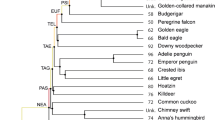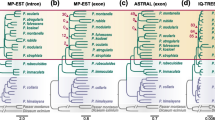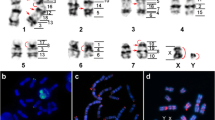Abstract
The hypothesis that tandemly repeated DNA sequences may facilitate chromosomal rearrangements was tested by comparing a conservatively evolving karyotype of a bat species (Macrotus waterhousii) with data published for a rapidly evolving karyotype of an equid species (Equus zebra). Empirical data generated from the phylogenetic screening of rapidly evolving repetitive DNAs from approximately 0.1% of theM. waterhousii genome showed only one sequence that was repetitive inM. waterhousii but low in copy number or absent from the outgroupArtibeus jamaicensis. This compares to 34 such clones containing sequences which were repetitive inE. zebra but were low in copy number or absent from the outgroupCeratotherium simum. The bat sequence represents a single family of repeated sequences, whereas six families of sequences were identified inE. zebra. Southern blot analysis suggested that the sequence fromM. waterhousii is interspersed rather than tandemly repeated, as are the sequences inE. zebra. These data support the above hypothesis and suggest that species with conservatively evolving karyotypes have fewer numbers and families of rapidly evolving DNA sequences than do species such as the equids that possess a karyotype that is considered to have undergone rapid karyotypic evolution.
Similar content being viewed by others
References
Baker RJ (1979) Karyology. In: Baker RJ, Jones Jr. JK, Carter DC, eds.Biology of bats of the New World family Phyllostomidae, Part III. Lubbock, TX: Special Publications, The Museum, Texas Tech University, pp. 107–156.
Baker RJ, Bickham JW (1980) Karyotypic evolution in bats: Evidence of extensive and conservative chromosomal evolution in closely related taxa.Syst Zool 29: 239–251.
Baker RJ, Wichman HA (1990) RetrotransposonMys is concentrated on the sex chromosomes: implications for copy number containment.Evolution 44: 2083–2088.
Baker RJ, Hood CS, Honeycutt RL (1989) Phylogenetic relationships and classification of the higher categories of the New World bat family Phyllostomidae.Syst Zool 38: 228–238.
Baker RJ, Maltbie M, Owen JG, Hamilton MJ, Bradley RD (1992) Reduced number of ribosomal sites in bats: evidence for a mechanism to contain genome size.J Mammol 73: 847–858.
Burton DW, Bickham JW (1989) Heterochromatin variation and DNA conservatism inGeomys attwateri andG. breviceps (Rodentia: Geomyidae).J Mammol 70: 580–591.
Burton DW, Bickham JW, Genoways HH (1989) Flow cytometric analyses of nuclear DNA in four families of neotropical bats.Evolution 43: 756–765.
Bush GL, Case SM, Wilson AC, Patton JL (1977) Rapid speciation and chromosomal evolution in mammals.Proc Natl Acad Sci USA 74: 3942–3946.
Finnegan DJ, Will BH, Bayev AA, Bowcock AM, Brown L (1982) Transposable DNA sequences in eukaryotes. In: Dover GA, Flavell RB, eds.Genome Evolution. London: Academic Press, pp. 29–40.
Graphodatsky AS (1989) Conserved and variable elements of mammalian chromosomes. In: Halhan CRE, ed.Cytogenetics of animals. Oxford, UK: CAB International Press, pp. 95–123.
Hamilton MJ (1989) Intragenomic movement and concerted evolution in satellite DNA in peromyscine rodents: Evidence fromin situ hybridization.Unpublished Ph.D. dissertation, Texas Tech Univ., Lubbock, TX, USA 86 pp.
Hamilton MJ, Honeycutt RL, Baker RJ (1990) Intragenomic movement, sequence amplification, and concerted evolution in satellite DNA in harvest mice,Reithrodontomys: Evidence fromin situ hybridization.Chromosoma 99: 321–329.
Hamilton MJ, Hong G, Wichman HA (1992) Intragenomic movement and concerted evolution of satellite DNA inPeromyscus: evidence fromin situ hybridization.Cytogenet Cell Genet 60: 40–44.
Hatch FT, Bodner AJ, Mazrimas JA, Moore DH (1976) Satellite DNA and cytogenetic evolution: DNA quantity, satellite DNA, and karyotypic variation in kangaroo rats (genusDipodomys).Chromosoma 58: 155–168.
Hong G (1992) Intragenomic movement and concerted evolution of a 4.8 kb tandemly repeated DNA family during rapid karyotypic evolution in Equiidae.Unpublished M.S. thesis, University of Idaho, Moscow, ID, USA, 29 pp.
Hsu TC, Pathak S, Chen TR (1975) The possibility of latent centromeres and a proposed nomenclature system for total chromosomal and whole arm translocations.Cytogenet Cell Genet 15: 41–49.
Kass DH, Berger FG, Dawson WD (1992) The evolution of coexisting highly divergent LINE-1 subfamilies within the rodent genusPeromyscus.J Mol Evol 35: 472–485.
Koopman KF (1984) Bats. In Anderson S, Jones JK, Jr. eds.Orders and Families of Recent Mammals of the World. New York: John Wiley and Sons, pp. 145–186.
Lande R (1979) Effective deme size during longterm evolution estimated from rates of chromosomal evolution.Evolution 33: 234–251.
Lloyd JA, Lamb AN, Potter SS (1987) Phylogenetic screening of the human genome: Identification of evolutionarily variable repetitive sequence families.Mol Biol Evol 4: 85–98.
Lima-de-Faria A. (1980) Classification of genes, rearrangements, and chromosomes according to the chromosome field.Hereditas 43: 1–46.
Meyne J, Baker RJ, Hebarf HH,et al. (1990) Distribution of nontelomeric sites of the (TTAGGG)n telomeric sequence in vertebrate chromosomes.Chromosoma 99: 3–10.
Miro R, Clemente IC, Fuster C, Egozcue J (1987) Fragile sites, chromosomal evolution, and human neoplasia.Hum Genet 75: 345–349.
Naveria JE, Fointdevila A (1985) The evolutionary history ofDrosophila buzzatii: IX. High frequencies of new chromosomal rearrangements induced by introgressive hybridization.Chromosoma 91: 87–94.
Pathak S, Hsu TC, Arrighi FE (1973) Chromosomes ofPeromyscus (Rodentia, Cricetidae): IV. The role of heterochromatin in karyotypic evolution.Cytogenet Cell Genet 11: 315–326.
Patton JC, Baker RJ (1978) Chromosomal homology and evolution in phyllostomatoid bats.Syst Zool 27: 449–462.
Qumsiyeh MB, Baker RJ (1985) G- and C-banded karyotypes of the Rhinopomatidae (Microchiroptera).J Mammol 66: 541–544.
Redi CA, Garagna S, Zuccotti M (1990) Robertsonian chromosome formation and fixation: The genomic scenario.Biol J Linn Soc 41: 235–255.
Reeder TW (1990) The isolation and characterization of hypervariable repetitive DNA sequences in the deer mousePeromyscus leucopus.Unpublished M.S. Thesis, University of Missouri-Kansas City, Kansas City, MO, USA, 152 pp.
Shaw DD, Wilkinson P, Coates DJ (1983) Increased chromosomal mutation rate after hybridization between two species of grasshoppers.Science 220: 1165–1167.
Southern EM (1975) Detection of specific sequences among DNA fragments separated by gel electrophoresis.J Mol Biol 98: 503–517.
Wang L (1992) Molecular correlates of rapid chromosomal evolution in equids: Characterization of four tandemly repeated DNA families.Unpublished M.S. Thesis, University of Idaho, Moscow, ID, USA, 23 pp.
Wichman HA, Potter SS, Pine DS (1985)Mys, a family of mammalian transposable elements isolated by a phylogenetic screening procedure.Nature 317: 77–81.
Wichman HA, Payne CT, Reeder TW (1990) Intrageneric variation in repetitive sequences isolated by phylogenetic screening of mammalian genomes. In: Clegg M, O'Brien SJ, eds.Molecular Evolution. New York: Alan R. Liss Inc., pp. 153–160.
Wichman HA, Payne CT, Ryder OA, Hamilton MJ, Maltbie M, Baker RJ (1991) Genomic distribution of heterochromatin sequences in equids: implications to rapid chromosomal evolution.J Heredity 82: 369–377.
Wilson AC, Bush GL, Case SM, King MC (1975) Social structuring of mammalian populations and rate of chromosomal evolution.Proc Natl Acad Sci USA 72: 5061–5065.
Wright S (1941) On the probability of fixation of reciprocal translocations.Am Nat 75: 513–525.
Wurster-Hill DH, Ward OG, Davis BH, Park JP, Moyzis RP, Meyne J (1988) Fragile sites, telomeric DNA sequences, B chromosomes, and DNA content in raccoon dogs,Nyctereutes procyonides, with comparative notes on foxes, coyotes, wolf and raccoon.Cytogenet Cell Genet 49: 278–281.
Author information
Authors and Affiliations
Rights and permissions
About this article
Cite this article
Bradley, R.D., Wichman, H.A. Rapidly evolving repetitive DNAs in a conservative genome: A test of factors that affect chromosomal evolution. Chromosome Res 2, 354–360 (1994). https://doi.org/10.1007/BF01552794
Received:
Revised:
Accepted:
Issue Date:
DOI: https://doi.org/10.1007/BF01552794




